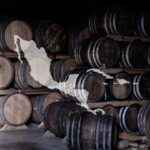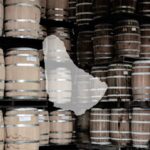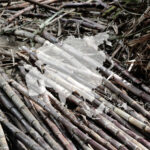Rum from Haïti, get to the bottom of the bottle
Why does a rum from Haiti develop this aromatic profile? Let’s go from the bottle to the cane to find out.

“Bonjour monsieur le caviste.
– Ah, good morning dear amateur in search of knowledge. To what do I owe your visit today, after yesterday and the day before, and… the day before that?
– Well, I’ve heard about one of the origins of rum that I know nothing about.
– What about it? Which one is it?
– Haïti.
– Ah, that’s an interesting provenance. But to understand it, you’ll have to taste two very different products.
– Be that as it may, I’ll stop at nothing!
These are more or less the few words exchanged with the wine merchant, before you leave with two bottles in your wallet, or your stroller, why not.
As your advisor hasn’t told you much, you’re very curious about these two new acquisitions: a “white rum” and an aged rum. The only indication: “Finish with the white”. Instinctively, you would have done the opposite, but okay.
You follow the guide, and pour a few centilitres of the rum, which proudly displays an age statement on its label: 8 years.
The profile that rises to your nostrils reminds you of others, and you immediately think this is a molasses rum, where the cask is responsible for most of the aroma.
These include vanilla, nuts, wood and a touch of roast. Pleasant in its simplicity, it also gives off a relatively dry impression. On the palate, it reveals itself to be softer than expected, with a strong aromatic presence of caramel, before regaining its straightforwardness on the finish, during which a hint of citrus comes to the fore.
Blindly, you would have placed it somewhere in Latin America or perhaps Cuba.
But it’s not. In fact, this rum has one major difference: its raw material! Yes, it’s made from cane juice and/or syrup (cooked cane juice that has lost a lot of moisture and become concentrated). That’s a barrelful.
So how do you explain this huge disparity with the agricols rums you know? To do so, we’ll have to take another look at the production stages.
One thing’s for sure – and you’re right – the juice used for ageing must not have been an aromatic bomb. That’s why the barrel was able to leave such a deep mark on the liquid.
Short fermentation, column distillation and a high percentage of alcohol in the mash: these are the reasons behind the lightness of the distillate. The barrel – in this case made of French oak – is left with an (almost) blank canvas on which to draw the rum’s silhouette as it sees fit.
By the way, there’s only one historic rum distillery in Haiti, so I’ll leave it to you to find out which one it is. No, it’s not that complicated, and there’s absolutely nothing to gain.
Now it’s time to taste your second bottle. The white eau-de-vie your cellarman advised you to save for last.
As soon as the cork is removed, you understand why. The highly expressive liquid is literally trying to get out of the bottle and into your nostrils. Pouring it into the glass, you give it a few minutes before approaching your nose.
This only confirms your first impression: the cane juice is conquering, both vegetal and organic, almost animal. The fruit is very, very ripe, with a hint of truffle. A rich, intense rum. Except it’s not (though). In fact, you’ve just experienced clairin.
This “ancestor” of rum is made by traditional methods. No phase of the process has changed for decades, if not centuries. There are a few exceptions, where modern distillation columns are used, but most of the country’s (almost 500) producers have made no changes to their ancestral methods.
The main reason is to be found in the fermentation process and, above all, in the alembic still used and its settings – in other words, the famous marks.
Honestly, in the world of rum, there are few things more complicated than the typologies of Guyana rums. Don’t expect me to explain it all to you – I’m not planning to write a twelve-volume book on the subject. But here are a few points to keep in mind.
First of all, in English Guiana, rums are produced in the Demerara region, which runs alongside the river of the same name. In other words, the two terms are almost synonymous when it comes to rum.
By 1780, there were over 300 distilleries in the area. Ah well! Over the years, most closed and/or were absorbed by others. By the middle of the 20th century, there were just eight, and today, only one still exists: Diamond.
Of course, all the others have disappeared, but some distilling equipment has been repatriated to Diamond, owned by Demerara Distillers Limited (DDL). This means, for example, that Enmore rums are still produced, even though the distillery of the same name closed in 1994.
It’s as if every step is taken to accentuate the aromas.
Sugar cane is grown “the old-fashioned way”, without any synthetic inputs (no, manure doesn’t count), in polyculture, mechanically cut, then transported by ox or donkey.
They are then pressed without the addition of water (also known as imbibition), and the juice is transferred to these fermentation “vats”, usually wooden barrels. There are a great many varieties of cane in Haiti, some endemic to specific regions.
Fermentation is spontaneous (no yeast is added) and lasts at least five days. The cane wine is then distilled on a still, traditionally heated over an open fire. No filtration or alcoholic reduction before bottling.
The result is a cane brandy with an alcoholic percentage generally between 50% and 55%, which has never had water added to it during the production process. A true concentrate of spirits.
Depending on the varieties of cane used, the year’s climatic conditions, variations during fermentation (during which no controls, such as thermoregulation of the vats, are in place) and the hazards of direct-flame distillation, the resulting clairin can be markedly different from one year to the next.
This “vintage” effect makes for a fascinating exploration of this ancestral rum.
What’s true for the production of a single distillery is even more true between different distilleries.
A little aside: note that the term “vintage” is normally reserved for aged rums, especially in the context of geographical indications and other appellations of origin. For white rums, the term “harvest year” is more appropriate.
You’re now equipped with the knowledge you need to appreciate and understand the rums produced on Haitian soil, where a wide variety of cane distillates are produced. But there’s still plenty to taste before you’ve mastered this two-faced origin.




